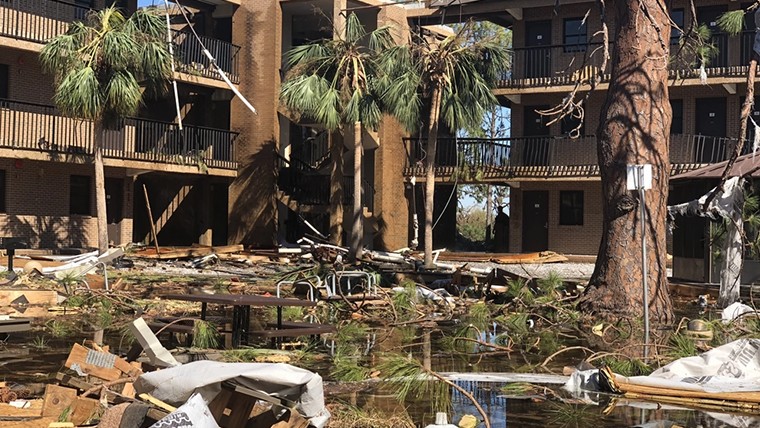As a result of this project, Tyndall is accessing instant data insights continuously delivered by DOD’s largest-ever digital twin—a massive, interconnected, systems-of-systems platform that has already ingested massive amounts of information for analysis and use. The data reflects almost 29,000 acres of geographic information system layers; 32,000 square feet of road and airfield pavement; 14,000 acres of terrain and topography in a digital elevation model; approximately 2.4 million feet of water, gas, and other utility assets; and more than 100 facility BIMs. Integration of enterprise data systems, such as real property and sustainment management (i.e., facility condition assessment) systems, feeds key data sets that enable never-before-seen analysis and contextualized visualization of results to support critical decisions.
Booz Allen helped Tyndall realize efficiencies and harness innovation at every stage of the solution. This support included optimizing the overall data strategy to ensure that the system and approach would meet user needs, as well as implementing an advanced data capture and integration system. Data capture included the use of small, unmanned aircraft system (sUAS)-mounted, vehicle-mounted, and hand-held photogrammetry and LiDAR to create engineering-grade infrastructure models. Capabilities like these are essential for representing legacy structures and ensuring an accurate “as-is” state for the digital twin from terrain contours to asset condition assessments. The integration of these models with existing data systems enables new analysis capabilities, allowing leaders to make more informed decisions.
Our team also improved the processing of the data to speed capture and built task-specific features and simulations on top of a baseline capability to enable multiple applications across the engineering lifecycle. We deployed these capabilities to users after user testing and device configuration to help the installation’s engineers and operators accomplish their work with greater effectiveness.
Today the Tyndall digital twin accurately visualizes the base in extended reality (XR) while preserving the engineering and technical data underpinning every object in the digital environment.
This work is enabling the Air Force to implement a powerful, user-friendly, technically sophisticated engineering tool for stakeholders at all levels to explore in the Tyndal Hololab. Tailored user experiences now serve the needs of multiple functional teams. And this project's data analysis and decision-making advantages extend throughout the revitalized base. A few examples:
- Reduced Change Order Costs: Early buy-in to designs before construction began is helping to prevent costly downstream change orders, potentially improving cycle times for critical design processes by up to 30%.
- Virtual design review of future buildings identified four structural anomalies during a single hour-long demo that would have otherwise resulted in change orders during construction.
- Another virtual design review enabled the correction of an equipment order before purchase when users recognized that the planned equipment would not fit in the allocated space.
- Providing an interactive virtual BIM environment for stakeholders to perform virtual walkthroughs and annotate issues could avoid an estimated total of $183 million in change-order costs.
- Optimized Crisis Response: With the capacity to simulate “what-if” scenarios using AI-powered modeling and simulation, base engineers can identify at-risk infrastructure during a flood event or simulate traffic movement to determine road and gate closures and optimize responses.
- Increased Alert Context: The digital twin gives operators context to sensor alerts in a facility, helping them validate if, for example, a fire alarm is going off while thermostats throughout the building show normal temperatures, helping identify nuisance alarms more quickly.
- Vast Range of Simulation Scenarios: The 325th Security Forces Squadron is using the open architecture of the COTS platform underpinning the digital twin to provide critical and accurate data to Ares Security to simulate multiple scenarios, including active shooter scenarios at the Tyndall elementary school; gate runner actions on the airfield; and sUAS attacks; to identify other threat vectors and risk reduction strategies; and to evaluate new security technology before implementation.

 Tyndall AFB student barracks after Hurricane Michael.
(The appearance of U.S. Department of Defense (DOD) visual information does not imply or constitute DOD endorsement.)
Tyndall AFB student barracks after Hurricane Michael.
(The appearance of U.S. Department of Defense (DOD) visual information does not imply or constitute DOD endorsement.)



